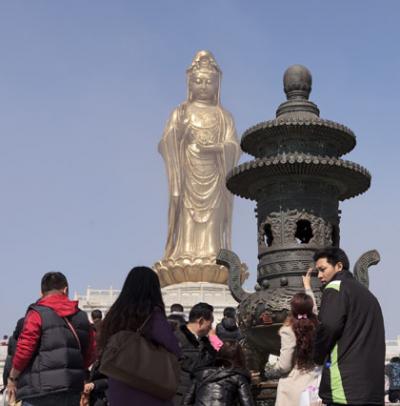
The Divine Femine Meets Big Tex

What an unexpected but delightful surprise to open a recent issue of The Loop and see extensive reference made to the ancient sacred home of Asia’s most revered spiritual deity: The Goddess of Compassion, Kuan Yin.
In his article, The Great Golden Buddha of Pu Tuo Shan, Biffle French recounts visiting along with hundreds of pilgrims this famous shrine situated on what is one of China’s Nine Sacred Mountains – the mountain island of Pu To, also called Pu Tuo Shan.
The island of Pu To has been a holy place for over 2,000 years. It was so at the beginning for Taoists, then became so a thousand years later for Mayahana Buddhists. The island, first mentioned in the Flower Ornament Sutra (a Buddhist sacred text) in the eight century CE/AD as Potolaka, became known as the sacred home of Kuan Yin, She Who Hears the Cries of the World. Since the eighth century, the divine reputation of Kuan Yin has grown until she is now revered by more people throughout Asia than Buddha himself.
The photo accompanying Mr. French’s article shows Kuan Yin gesturing for peace with her right hand and holding the Lotus Sutra (another Buddhist sacred text) in her left. Crowned with her distinctive headdress and draped in robes of purity, she stands upon the Sacred Lotus Blossom which among Buddhists symbolizes the flowering of the mind.
As a Bodhisattva, Kuan Yin attained great moral wisdom across many lives and incarnations. She at last attained spiritual perfection and was about to step across the threshold into Nirvana when all the creatures of earth cried out as one to Kuan Yin not to leave them behind. Though of the highest, purest nature and having merited her final release into Nirvana, Kuan Yin chose instead to return to earth in order to help liberate all life from conflict, pain and suffering.
The reverence with which Kuan Yin is held exemplifies the sense of spiritual and emotional sanctuary she provides her adherents during times of social upheaval, violence or catastrophe. So revered had she become by the Chinese people in the 1960s, Mao Zedong, in his quest for absolute, unchallenged power, caused the sacking of Po Tu and the destruction of over two-hundred of Kuan Yin’s temples. Since then Po Tu has begun to recover and regain its stature, though under the present Chinese government karaoke and disco bars – even prostitution – now intrude upon the ancient dignity of this sacred place.
Pu To, today, as Mr. French might attest, struggles against a rising tide of tourism, the encroachments of modern transport, and unrelenting consumerist development and growth. The Goddess, as Mr. French photographed her, stands gilded and serene above the throng, looking down tenderly - a loving mother hearkening to the proffering of incense and the clinking of alms. An untarnished symbol of love and compassion, she listens with her heart to the silent sorrows and unspoken pain of her children.
As we hurl ourselves headlong toward an ever-more contentious, fractured and desecrated world of our own making, will the fury of our machines and the maelstrom of our insatiable consumption so overwhelm our cries for help that even Kuan Yin will no longer hear?
- Login to post comments
